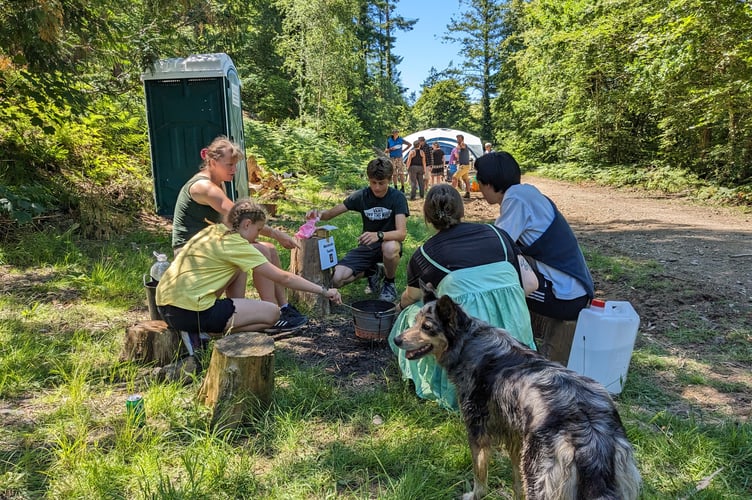AN OPEN day was the chance to find out how a local woodland is being restored.
High Wood, to the north of Liskeard, is an ancient woodland which was replanted in the 1960s as a conifer plantation for timber production.
Before the felling, this temperate rainforest would have been home to an abundance of wildlife: sunlit, with ferns growing out of the mosses on big oak trees, a rich habitat for many creatures and plants. But dense uniform rows of non-native evergreen species like Douglas Fir and Sitka Spruce have created a dark environment, lacking the usual layers found in a broadleaved woodland, and unfavourable to wildlife.

In Spring 2022, the 64-acre High Wood was acquired by Protect Earth, a charity that creates and restores woodland all around the UK. The charity’s aim is to plant as many trees as possible to aid carbon capture and mitigate climate crisis, at the same time benefiting wildlife and enabling more people to enjoy access to nature.
Thanks to the combined efforts of the charity’s staff and a large number of willing volunteers, High Wood is gradually opening up and regenerating, as Protect Earth chairman Phil Sturgeon explains.
“If you look carefully amongst the conifers, some mature oaks remain, and there are many other native species naturally returning. High Wood is trying to turn itself back into temperate rainforest, but it will need some help to do so.
“Protect Earth’s vision is to restore the wood to its former glory through the thinning and eventual removal of the conifer stands, by encouraging natural regeneration, and by planting thousands of broadleaf trees. As our work progresses and native species return, High Wood will become a more balanced and diverse ecosystem, which will improve the carbon sequestration.”
Early in 2023, contractors carefully extracted 900 tonnes of non-native conifer, giving the remaining semi-mature Oaks space to reach their full potential.
Local volunteers then helped to remove young conifers before they became established and have planted nearly 1000 native broadleaf trees and shrubs, including some regional specialities such as Devon Whitebeam and Cornish Elm.
Nest-boxes have been installed to encourage more varieties of birds, and safe camp fire areas have been set up, to reduce wildfire risk.
Mountain bike trails have been modified with the help of local mountain bikers to reduce any conflicts with walkers.
“Protect Earth purchases land through donations to our Land Fund from individuals, companies, and philanthropic donors. We have been incredibly lucky to have so many donations, but as High Wood is such a magical place it is easy to understand why,” says Phil.
“Income generated from selectively thinning High Wood’s alien conifers is going into future maintenance of the site (things like improving trails, information boards, and community events), and eventually there will be no more need for timber extraction because all of the conifers will be gone.
“Since December we’ve removed 80% of the conifers in the area we were trying to clear. It has been tough slow work, working with countless volunteers from Liskeard and surrounding areas. We’ll get the rest cleared in September once nesting season is over.
“Basically, we want to return High Wood to what it would have been hundreds of years ago. We’re just taking away problematic species, removing invasive species like rhododendron ponticum, and reintroducing less common local species that would not have come back by themselves, like Cornish Elm, Plymouth Pear, and Wild Service Tree.
“I am honoured to have been part of this, as I’ve had the chance to work through several seasons, planting, improving mountain bike trails with local riders, and clearing forestry brash to reduce wild fire risk in the height of last summer’s heatwave. I’ve constantly been amazed by the dedication of the local community to work through adverse conditions to get the job done. No matter what job needs doing, people of all ages and abilities have come out in droves to support the restoration of High Wood.”
There is still a great deal of work to do and the restoration will take many years to fully complete, says Phil.
Over the coming winters, Protect Earth will continue to remove conifers until most have gone, and more native trees will be planted. There are plans to improve access for horseriders, to install more nesting boxes for birds, owls and doormice, and to keep improving the paths and facilities in the woods for its many visitors and different user groups.
The charity is also considering creating a community orchard with heritage native apple varieties, so that people can enjoy a snack as they walk in the wood at various times of the year.
“This would not have been possible before as the conifers made much of the woods unnaturally dark,” Phil explains, “but since the timber operations earlier this year, there is noticeably more light in the woods.”
A Friends of High Wood Group has been formed representing the main stakeholders of the woods: neighbours, dog walkers, runners, mountain bikers, and horse riders. This group helps with management decisions, and keeping an eye on the wood. There’s also a mailing list of volunteers to help with planting and maintenance – and more volunteers are always very much welcomed to either group.
During a recent open day, people enjoyed finding out about the project and learning about the birds, insects and plantlife in the woods with ecologist Steve Wiltshire. After marshallow toasting and a barbecue hosted by Mieke from Forest for Cornwall, a medicinal foraging walk was led by local friend of the woods Margarita, who explained the historical and current day uses of lots of common plants like Hawthorn and stinging nettles.
To find out more and sign up visit https://www.protect.earth.uk




